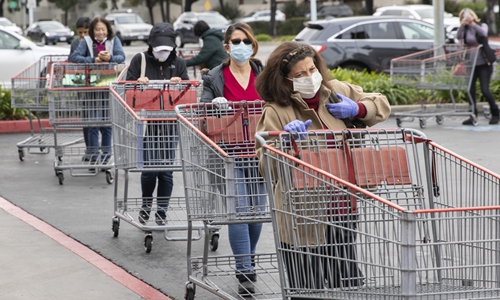US infections likely to grow to 20,000 by next weekend: China CDC chief epidemiologist
US cases to double next week

US citizens queue up to buy daily necessities at a supermarket in San Francisco, the US on March 16. Photo: CNS photo
As California became the only US state to issue a "stay at home" order on Thursday with the nationwide spike in COVID-19 cases this week, experts who believed that the US coronavirus epidemic will quickly rise in the following weeks warned that the US may witness the number of reported cases double before the end of next week and a steadily worsening epidemic for weeks.
It's very likely that the number of confirmed cases in the US will grow to more than 20,000 by next weekend or even sooner given that the US coronavirus epidemic is fast spreading, Zeng Guang, chief epidemiologist of the Chinese Center for Disease Control and Prevention (CDC), told the Global Times on Friday.
It took China four days for the number of confirmed cases to rise from 100 to 1,000, and 10 days for the US. And from 1,000 to 10,000, it took China seven days and the US nine days. From 10,000 to 20,000, it took China three days.
Some analysts forecast there would be about 50,000 to 500,000 infections in the US, and the US has adopted an influenza-tackling policy which will see 28 million infections, 250,000 in hospitals and 16,000 deaths. "We may see much higher infections, and may reach a similar range as influenza," Chen Xi, an assistant professor of public health at Yale University, told the Global Times on Friday.
Some Harvard University research also said 30 percent to 60 percent of the US population could be infected, Chen said.
The US has recorded more than 10,000 confirmed COVID-19 cases as of Thursday, doubling over two days as states increased testing and the virus continued to spread across the country.
To prevent further spikes, California has asked its residents to stay inside as much as possible, although they could still spend time outside as long as they stay six feet away from other people. The order was called by some US media as the "most aggressive action" taken by a governor so far.
However, medical experts said that the US' actual number of cases could be much higher, considering its delayed and insufficient tests nationwide, and its rather "loose" advice instead of mandatory measures from state governments may push the number of infections significantly higher in the following weeks as young people who don't take the control policies seriously still hang out.
Testing in the US has been hampered by delays and strict criteria on who could get tested. Some US netizens complained that their test results took a week, calling on "aggressive tests" across the country.
So far, both public and private labs have run about 60,000 tests in the US for a population of 330 million, federal officials said Tuesday. However, Wuhan City ran a daily average of 20,000 tests in February.
Zeng said that US public health sectors have yet displayed their full potential due to politics.
It's not that US health departments run by its government have no ability to test more, it's that Trump administration officials do not listen to public health experts, Zeng said.
The supply shortage of materials used in tests has also led to the insufficient and delayed tests.
The US has been short on the reagent chemical used in tests since last week, and this week, a lack of swabs used for tests became the new bottleneck, US media reported.
Several counties in Washington and Michigan have reported a limited number of swabs which resulted in a logjam in their testing capabilities, National Public Radio reported on Wednesday.
Peng Zhiyong, director of the intensive care unit of Wuhan University's Zhongnan Hospital, told the Global Times that he received a growing number of phone calls and emails this week from his US counterparts seeking treatment plans not just for elderly people, the normally considered high risk group, but also for young people.
"Some American doctors who called me have been saying that the US has recorded a relatively high infection rate among younger people, as they are reluctant to listen to government advice," Peng said.
US CDC data showed that nearly 40 percent of US hospitalized COVID-19 patients are between the ages 20 to 54.
Peng said that to reduce the new infections, the US has to adopt strict and mandatory measures, such as curfew for all states, to stop large gatherings.

